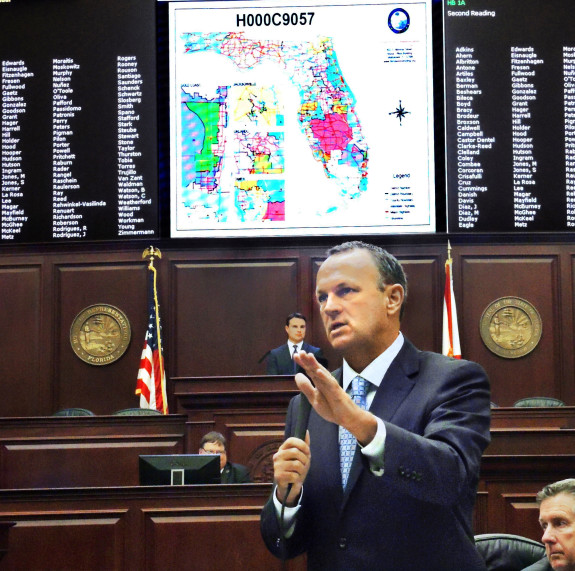
The Florida Legislature passes a new congressional map that barely changes the state’s political calculus. (Photo myfloridahouse.gov)
By Ashley Lopez
Florida Center for Investigative Reporting
The Florida Legislature’s special session to redraw the state’s congressional districts has ended now that lawmakers passed a new set of maps. However, Democrats and others argue the maps still mirror Florida’s actual political makeup.
As the Associated Press reports, “the changes would reshape the boundaries of seven of the state’s 27 congressional districts, but it’s not certain if the revised map will result in a change the makeup of Florida’s congressional delegation…. Republicans currently hold a 17-10 edge even though President Barack Obama twice carried the state..”
Several weeks ago, Circuit Court Judge Terry Lewis ruled state lawmakers violated a set of voter-backed laws aimed at stopping the Legislature from drawing politically motivated maps.
According to Lewis, lawmakers facilitated a “secret, organized campaign” wherein partisan political operatives influenced the redistricting process in violation of the Fair Districts Amendments, which mandates the state draw districts without political party favoritism.
The lawsuit alleging the GOP-led Legislature broke those laws was filed by the Florida League of Women Voters, as well as a group of voters. Officials with the League had asked the judge to not appoint the Legislature to redraw the maps. However, the Legislature was ultimately tasked with the job with a strict turnaround.
Now, Democrats and the plaintiffs in that case are crying foul on these new maps.
According to The Miami Herald/Tampa Bay Times:
While the GOP legislative leaders praised themselves for creating a map that followed Lewis’ order, Democrats complained they were excluded and predicted the new map likely will be thrown out like the previous one.
“This was a dog-and-pony show, and unfortunately that’s what we’re going to send back to the judge on Friday,” said Rep. Mark Pafford, D-West Palm Beach.
Sen. Jeff Clemens, D-Lake Worth, called the new map “window dressing” that “doesn’t meet the goals again.”
Redistricting experts said that, if approved by the judge, the new map will change little politically.
“A lot of furniture has been rearranged but it looks like the old house with the same rooms,’’ said Michael McDonald, an associate professor of political science at the University of Florida and an expert on redistricting. “I would not think any incumbents will be defeated as a result of this plan.”
The Democrat-leaning voters groups that brought the lawsuit said the new map perpetuates the flaws enacted by legislators in 2012 and said they will argue that the map should be rejected and redrawn by the court.
…“We do not believe Map 9057 complies with Judge Lewis’s order or the Fair Districts Amendments,’’ said Deirdre Macnab, president of the League of Women Voters of Florida, one of the plaintiffs in the lawsuit. ”We will continue to urge Judge Lewis to adopt a constitutionally compliant map for the 2014 elections.”
Voting for the map in the Legislature fell mostly along party lines. Even though the changes affect up to seven districts, this barely changes the political calculus in the state at all.
However, Republicans contend that’s because the maps were drawn without consideration for political makeup.
The E.W. Scripps / Tampa Tribune Tallahassee bureau reported:
State Sen. Bill Galvano, the Bradenton Republican who led the Senate’s special session map-drawing, said that partisan data could not be considered when drawing the maps because of the Fair District amendments.
“You can’t engineer the political performance,” he said. “If you fix it, you violate the constitution.”
Democrats also took issue with the fact the new maps would specifically not become law until after 2014. They are hoping for congressional elections this year to be held on the new maps, a plan Republicans say would disenfranchise votes already cast by mail.In his order, Lewis held out the possibility of a special election for the districts impacted, but also stated he was unsure if he could legally change election dates.
The AP also reported, “Senate Democrats offered their own alternate map that changed just three districts, but it was voted down on a 25-12 vote.”
Republicans contended that the Democratic map was unconstitutional because it lowered the number of black voters in [Corrine] Brown’s district. The federal Voting Rights Act bars states from diluting the voting strength of minorities.
As Slate’s Dave Weigel points out, this aspect of the VRA has actually help Republicans quite a bit:
The state Senate, given until Aug. 15 to draw a new map, finished its work early and voted it through. If you click that link and look for the 5th District, you may notice that it still snakes from Jacksonville, down into the Orlando area. As Alice Ollstein pointed out, “the new map proposed by state legislators would reduce Brown’s district to 48 percent African-American, while boosting her neighbor’s district–represented by Rep. Dan Webster (R-FL) from 10 to over 12 percent African-American.”
The alliance is unbroken. This is really part of the plan for continuing Republican dominance of congressional and legislative delegations for years. In every Republican-run state with a significant black population, the reliably Democratic black vote is packed into as few districts as possible—Florida, Georgia, Michigan, North Carolina, Pennsylvania. As Rick Scott showed in 2010, this is one aspect of Voting Rights Act preclearance that the Republican-run states are perfectly OK with.
There is a scheduled hearing set for Aug. 20 for Lewis to hear arguments about the new map and Gov. Rick Scott plans on signing it quickly into law.
